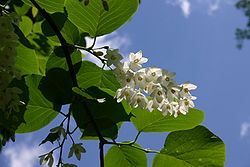Styrax
| Lifespan: | ⌛ | perennial |
|---|
| Features: | ✓ | evergreen, deciduous |
|---|
|
Styrax > |
If this plant info box on watering; zones; height; etc. is mostly empty you can click on the edit tab and fill in the blanks!
Styrax is a genus of about 130 species of large shrubs or small trees in the family Styracaceae, mostly native to warm temperate to tropical regions of the Northern Hemisphere, with the majority in eastern and southeastern Asia, but also crossing the equator in South America[1]. Common names include styrax, or the more ambiguous storax, snowbell, and benzoin.
The genus Pamphilia, sometimes regarded as distinct, is now included within Styrax based on analysis of morphological and DNA sequence data.[2] The spicebush (Lindera benzoin) is a different plant, in the family Lauraceae.
Styrax trees grow to 2-14 m tall, and have alternate, deciduous or evergreen simple ovate leaves 1-18 cm long and 2-10 cm broad. The flowers are pendulous, with a white 5-10-lobed corolla, produced 3-30 together on open or dense panicles 5-25 cm long. The fruit is an oblong dry drupe, smooth and lacking ribs or narrow wings, unlike the fruit of the related snowdrop trees (Halesia) and epaulette trees (Pterostyrax).
Read about Styrax in the Standard Cyclopedia of Horticulture
|
|---|
|
Styrax (ancient Greek name of Styrax officinalis). Styracaceae. Storax. Ornamental woody plants chiefly grown for their handsome flowers. Deciduous or evergreen trees or shrubs more or less stellate-pubescent: lvs. short-stalked, exstipulate, more or less covered, like the infl., with stellate hairs: fls. white; calyx campanulate, obscurely 5-toothed or truncate; petals 5, connate only at the base; stamens 10, inserted at the base of the corolla and usually somewhat connate below; ovary superior, often united at the base with the calyx, 3-loculed at the base, 1-loculed at the apex; style slender: fr. a drupe, mostly subglobose, fleshy or oftener dry with dehiscent pericarp, 1-2-seeded, with large, subglobose seeds.—About 100 species in the tropical, subtropical and warmer temperate regions of Amer., Asia, and Eu. There is a monograph by Miss J. Perkins in Engler, Pflanzenreich (IV. 241), Styracaceae, pp. 17-88 (1907). S. Benzoin yields the benzoin, a balsamic exudation of the wounded tree; storax, a similar gum-resin, was formerly obtained from S. officinalis, but the storax of today is a product of Liquidambar. The storaxes are handsome shrubs of graceful, usually loose and spreading habit with numerous white and mostly fragrant, often pendulous, flowers in racemes or few-flowered clusters, followed by rather insignificant subglobose drupaceous fruits. S. japonica and S. Obassia are the hardiest and stand the winter in sheltered positions as far north as Massachusetts. S. americana is somewhat tenderer; S. grandifolia is hardy about Philadelphia and S. Wilsonii is probably of the same hardiness; S. officinalis is hardy only South. They are well adapted for borders of shrubberies or as single specimens on the lawn, and thrive best in a light, porous soil. Propagation is by seeds which are usually profusely produced in cultivation, sown soon after ripening, and by layers sometimes grafted on Halesia carolina; S. japonica and S. americana may also be grown from cuttings, but usually only a small percentage will root. S. Benzoin, Dry. Small tree, allied to S. japonica: lvs. stellate-tomentose beneath, also pedicels and calyx. Malay Archipelago.— S. dasyantha, Perkins. Shrub or small tree, to 25 ft.: lvs. obovate to oblong, acuminate, serrulate, sparingly stellate-pilose, 2 1/2 - 4 in. long: fls. nearly 1/2 in. long, in many-fld. racemes or panicles. Cent. China. Var. cinerascens, Rehd. Lvs. stellate-tomentose beneath.— S. Hemsleyana, Diets. Shrub or tree, to 30 ft.: lvs. broadly ovate, acuminate, serrate, pubescent on the veins beneath, 3-6 in. long: fls. 3/4 - l in., in long racemes, sometimes panicled. Cent, and W. China.—S. platanifolia, Engelm. Allied to S. californica. Almost glabrous: lvs. undulate or irregularly sinuately lobed. Texas.—S. serrulata, Roxbg. Shrub or tree, 40 ft. high, allied to S. americana: lvs. usually elliptic-oblong, acuminate, distinctly serrulate: fls. short-pedicelled, in 5-10-fld. short racemes; calyx and pedicels tomentose. E. India.—S. Shiraiana, Makino. Small tree: lvs. rhombic to orbicular, coarsely toothed, nearly glabrous. 1 1/2-3 in. long: fls. nearly 1 in. long, in short racemes. Japan.—S. Veitchiorum, Hemsl. & Wilson. Tree, to 30 ft.: lvs. lance-ovate to oblong-ovate, acuminate, denticulate, glabrous, 3-4 1/2 in. long: fls. over 1/2 in. long, in many-fld. racemes or panicles: bears the large galls found on S. Benzoin and other species. Cent. China.
|
Cultivation
Propagation
Pests and diseases
Species

Johann Baptist Emanuel Pohl: Plantarum Brasiliae icones et descriptiones hactenus ineditae Vol. 1. (1827)
Gallery
References
External links
- w:Styrax. Some of the material on this page may be from Wikipedia, under the Creative Commons license.
- Styrax QR Code (Size 50, 100, 200, 500)


